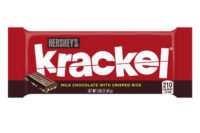Cover Story: Packaging Innovations
Top innovations in packaging
Developing a better package to answer the call for easier, greener and more innovative.






















Enhancing the user experience
Pre-mixed single-serve cocktails are popular for their easy, on-the-go packaging. One new package in the market marries that convenience with user interaction, allowing the consumer to mix the cocktail themselves. The Clasper™ bottle, engineered by Plastic Technologies Inc. (PTI; plastictechnologies.com) is a combination of two polyethylene terephthalate containers and a shrink label. Yumix portable, shelf-stable line of cocktails is the first commercialization of this new technology.
The package features two compartments: a 50ml bottom container, holding the alcohol, which snaps into the base of the larger top bottle, holding 6.5 ounces of hot-filled, shelf-stable juice. To use, the consumer separates the shrink sleeve at the seam between the top and bottom containers and unsnaps the bottom container from the base. The consumer then opens both compartments and pours the liquor into the juice, and voila, a cocktail is born.The Clasper package is not limited to cocktails; the size and shape of the compartments can be altered to accommodate a wide variety of other applications. It provides a unique packaging solution for food, beverage, pharmaceutical, nutraceutical, industrial and household chemical products. The Clasper concept enables two different products to be consumed in sequence or mixed together and then consumed.
In an attempt to make a pharmaceutical container look less like, well, a pharmaceutical container, Gerresheimer (gerresheimer.com) introduces a new member of the Duma Pocket product family, the Duma Pocket 100ml. The Duma Pocket’s oval shape makes it look more like a box of mints, rather than pills, and is so ergonomic that the user only needs one hand to hold and open the box. The package is perfect for dispensing tablets and is available in 30-, 50- and 100ml sizes. The container can be manufactured in any color, and in translucent or transparent, with side surfaces free for consumer information and branding. Duma Pocket 100ml is made of polypropylene and features a desiccant in the base to absorb moisture. Other features include an integrated closure with dispensing aid, a tamper evident seal, and the package is senior-friendly and child-resistant.
Focusing yet again on consumer’s experience of the package while it’s in their hands, Argo Tea’s new ergonomically shaped glass package from Owens-Illinois Inc. (o-i.com) delivers a high quality tea to consumers. Designed to fit perfectly in consumers’ hands, the bottle is meant to deliver a relaxing experience and is comfortable to hold and consume. Like all glass containers, the bottles can be recycled or reused for various purposes.
For added consumer convenience and to solve the pesky problem of complete product evacuation, there’s the VersaPouch from Glenroy Inc. (glenroy.com). The company recently launched the first premade version of its VersaPouch solution. The ready-to-dispense, gravity fed pouch eliminates the need for utensils when dispensing the product, and it allows for over 99% product evacuation. The space-efficient pouch is also designed for stability on shelves and for easy storage within refrigerator doors. AptarGroup’s (aptar.com) patented VersaPouch closure features an easy-to-open flip-cap, a built-in tamper-evident pull ring and an anti-spill SimpliSqueeze® valve. This customizable valve provides clean product cutoff (a must for clean kitchens) as well as controlled drip-free dispensing.
Ideal for medium to high-viscosity food and beauty and home products, the new premade version of VersaPouch places the innovative packaging format within reach of more brands than ever before. Providing a cost-effective alternative to existing form-fill-seal inverted pouches, the premade inverted pouch doesn’t require the capital outlay of a new machine.
Safety first
Advancing traceability in today’s complex global supply chain is critical for manufacturers to meet regulatory mandates and manage issues like quality, product recalls and manufacturing inefficiencies. To help brands improve product traceability and support greater consumer engagement, Crown Holdings Inc. (crowncork.com) has developed CrownSecure™, a code scanning system that assigns every package a unique and singular identity quick response (QR) code. During manufacturing and distribution, product information is stored in a central, reliable Cloud Datamatrix database and can be accessed at any time by brands, retailers or consumers by scanning a code on the container.
Why is this so important? The CrownSecure database assigns a unique ID to each package and stores a variety of information on the product (e.g., origination/expiration date/path of travel). As a result, brands can regularly update the product’s status, building a data trail, while consumers seeking to purchase the product can validate its authenticity at any time via a mobile phone or web application.
“The ability to scan and track products is highly relevant to today’s food and beverage markets,” says Christopher Ramsey, innovation manager for Crown Holdings Inc. “These industries are facing challenges that range from retailers or consumers seeking to identify a product’s origins all the way through to being able to provide a clear ‘paper trail’ if product recalls become necessary.”
For brands that are subject to counterfeiting, CrownSecure offers additional benefits as a means to protect brand reputation and identity. The unique data can be used to prove authenticity and that it has not been copied, resulting in several scans in multiple locations. Brands can also use the CrownSecure solution to enhance consumer engagement through promotional opportunities, and reward programs.
Saving the planet, one package at a time
In the marijuana marketplace, one company is bringing sustainable practices to its product through a new way to package the plant. Honest Marijuana Company packages cannabis in earth-friendly, reusable tin cans, a new concept to the industry. The cans, from N2 Packaging (n2pack.com), are made from food grade metal and have beveled edges for safe use. What’s more is that the tin cans feature a plastic lid (think of a similar one to a Pringles container) that can be easily removed and adhered to keep the product fresh.
This environmentally sound packaging allows for the product to stay in its purest form and not be deteriorated by light or oxygen. The cans preserve the cannabis flowers for years. The resealability keeps the product fresh and allows the consumer to use as little or as much at a time.
It might not get any greener than a fully compostable package, and that’s exactly what one new snack brand is delivering. Snact’s fruit jerky is available in 100% home compostable packaging, the first of its kind in the U.K. This innovative packaging, developed by Israeli start-up TIPA (tipa-corp.com), is just as durable and impermeable as ordinary plastic – but it biologically decomposes within 180 days, becoming a fertilizer for soil.
In tests run by TIPA’s labs to simulate home composting conditions, the new Snact packaging decomposed in just 24 weeks, behaving similarly to an orange peel. As most commonly available food packaging today is non-recyclable, this innovation marks a significant step to reduce the unsustainable volume of plastic waste currently generated by the industry.
Snact packs are TIPA’s first collaboration on the U.K. market. CEO and co-founder of TIPA, Daphna Nissenbaum, says that a brand like Snact, “a worthy brand in the fight against food waste,” was a natural fit for the partnership.
“We know that many consumers would prefer to treat their food packaging as a natural part of their kitchen waste. Over 9.6 million tonnes of plastic waste is sent to landfill every year in Europe and something has to change. At TIPA, we have the solution that will be a game-changer for the industry. We look forward to the beginning of a new era in packaging where for the first time, viable end of life solutions are available on the market,” says Nissenbaum.
In an effort to reduce materials used for packaging, Sealed Air Corporation (sealedair.com) launches its StealthWrap™ ultra-
durable cartoning solution that provides security and protection while eliminating the need for extra shipping cartons and packing materials. This patented micro-layer, opaque cartoning alternative allows primary package cartons to be protected for transit without the need for outer boxes or additional packaging materials, while maintaining that the product inside is not seen.
When applied, it shrinks and adheres to the dimensions of the product, obscures any markings or identification of the product inside and provides a strong, damage-resistant covering.
“Consumers have become accustomed to receiving a box within a box within a box, and while the material waste and inefficiency of that kind of packaging method is evident, it has long been the only method available to provide adequate protection for the manufactured item in its original packaging,” says Kenneth P. Chrisman,
president of Sealed Air’s product care division.
“The high-performance capabilities of StealthWrap can truly eliminate a significant amount of corrugated cartons from the global supply chain, bringing unprecedented simplicity, sustainability and cost efficiency to retailers, large-scale fulfillment operations and third-party logistics providers,” concludes Chrisman.
To increase a package’s recyclability, NoWaste Technology (NoW; nowastetechnology.com) has developed a revolutionary new process that makes laminated papers recyclable and 100% sustainable – just as if they were plain uncoated paper. The water-soluble application prevents bonding between the substrate (papers) and the coating, enabling delamination and recycling of the papers where before this was not possible. This allows for the recycling of the paper parts, even when used with plastic films and coatings. NoW technology can be used in many applications from coffee pouches to food service papers and in candy and gum wrappers.
Innovations in packaging roll out each year to address consumers’ demands for ease of use, sustainability, convenience and fun. Across all markets, consumers want these benefits in addition to keeping their food or drugs safe. Today’s new package innovations answer the call for all of these traits and then some.Looking for a reprint of this article?
From high-res PDFs to custom plaques, order your copy today!



















